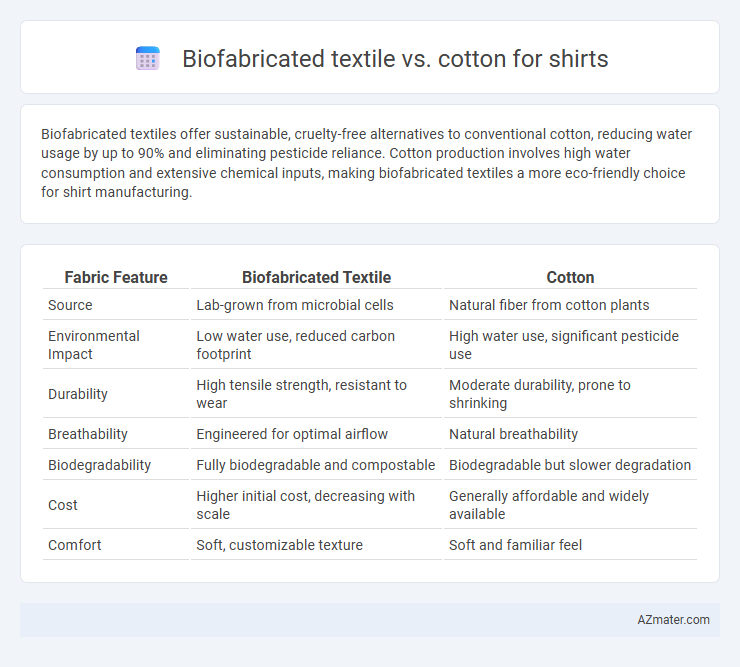Biofabricated textiles offer sustainable, cruelty-free alternatives to conventional cotton, reducing water usage by up to 90% and eliminating pesticide reliance. Cotton production involves high water consumption and extensive chemical inputs, making biofabricated textiles a more eco-friendly choice for shirt manufacturing.
Table of Comparison
| Fabric Feature | Biofabricated Textile | Cotton |
|---|---|---|
| Source | Lab-grown from microbial cells | Natural fiber from cotton plants |
| Environmental Impact | Low water use, reduced carbon footprint | High water use, significant pesticide use |
| Durability | High tensile strength, resistant to wear | Moderate durability, prone to shrinking |
| Breathability | Engineered for optimal airflow | Natural breathability |
| Biodegradability | Fully biodegradable and compostable | Biodegradable but slower degradation |
| Cost | Higher initial cost, decreasing with scale | Generally affordable and widely available |
| Comfort | Soft, customizable texture | Soft and familiar feel |
Introduction to Biofabricated Textiles and Cotton
Biofabricated textiles are engineered materials produced through microbial fermentation or cell culture techniques, offering sustainable alternatives to traditional fabrics with reduced environmental impact. Cotton, a natural fiber harvested from cotton plants, is widely used in shirt production but requires significant water, pesticides, and arable land for cultivation. Biofabricated textiles aim to minimize resource usage and pollution while maintaining breathable, soft qualities comparable to conventional cotton shirts.
Environmental Impact: Biofabricated Textiles vs Cotton
Biofabricated textiles significantly reduce water consumption and greenhouse gas emissions compared to conventional cotton farming, which requires extensive irrigation and pesticide use. These innovative materials often utilize renewable resources and industrial fermentation processes that minimize land degradation and chemical runoff. The lower environmental footprint of biofabricated textiles supports sustainable fashion by decreasing reliance on resource-intensive cotton cultivation.
Production Processes Compared
Biofabricated textiles are created using microbial fermentation and cellular agriculture, offering a sustainable alternative that reduces water consumption and greenhouse gas emissions compared to traditional cotton farming. Cotton production involves intensive land use, heavy pesticide application, and significant water requirements, often leading to environmental degradation. The biofabrication process enhances material consistency and scalability while minimizing ecological impact, making it a revolutionary shift in textile manufacturing.
Durability and Performance in Shirts
Biofabricated textiles exhibit superior durability compared to traditional cotton, offering enhanced resistance to wear, tear, and environmental stressors. These advanced materials maintain structural integrity and color vibrancy longer, providing consistent performance during extended use and multiple washes. Cotton, while breathable and soft, tends to degrade faster under heavy use, making biofabricated fabrics a more resilient choice for high-performance shirts.
Comfort and Breathability Analysis
Biofabricated textiles exhibit superior moisture-wicking properties and enhanced breathability compared to traditional cotton, promoting better temperature regulation during wear. These materials often feature engineered microstructures that facilitate airflow and reduce heat retention, leading to increased comfort in both hot and humid conditions. Cotton, known for its natural softness, can absorb moisture but tends to retain dampness longer, which may cause discomfort and a clammy feeling in active or warm environments.
Cost and Accessibility for Consumers
Biofabricated textiles for shirts tend to have higher production costs due to advanced manufacturing processes and limited large-scale infrastructure, resulting in higher retail prices compared to traditional cotton shirts. Cotton remains more accessible to consumers because of its widespread availability, established supply chains, and economies of scale that lower costs. Budget-conscious buyers often prefer cotton shirts, while biofabricated alternatives appeal to niche markets seeking sustainable innovation despite the premium price.
Sustainability and Resource Efficiency
Biofabricated textiles outperform cotton in sustainability by significantly reducing water consumption and land use, as they are produced through cellular agriculture without the need for traditional farming. Cotton cultivation requires large amounts of water, pesticides, and fertilizers, contributing to soil depletion and environmental pollution. The resource efficiency of biofabricated textiles also minimizes carbon emissions and waste, making them a more environmentally friendly alternative for shirt production.
Fashion Industry Adoption Trends
Biofabricated textiles are gaining traction in the fashion industry due to their sustainable production methods and reduced environmental impact compared to traditional cotton. Leading fashion brands increasingly adopt biofabricated materials to meet consumer demand for eco-friendly apparel and to align with corporate sustainability goals. Market analysis shows a significant rise in investment and innovation surrounding biofabricated fabrics, positioning them as a viable alternative to cotton in shirt manufacturing.
Consumer Perception and Acceptance
Consumer perception of biofabricated textiles for shirts often highlights sustainability and innovation compared to traditional cotton, which is associated with natural feel and comfort. Acceptance rates for biofabricated textiles are growing, driven by increasing environmental awareness and demand for cruelty-free alternatives, although some consumers remain hesitant about texture and durability. Market studies indicate that educating consumers on biofabrication processes and environmental benefits significantly enhances willingness to adopt these textiles over cotton.
Future Outlook for Shirt Materials
Biofabricated textiles offer a sustainable alternative to traditional cotton with reduced environmental impact and faster production cycles, aligning with growing eco-conscious consumer demand. Advancements in bioengineering enable the creation of customizable, biodegradable materials that maintain comfort and durability comparable to cotton. Innovation in this sector is expected to drive widespread adoption in the apparel industry, positioning biofabricated textiles as a key material for future shirt production.

Infographic: Biofabricated textile vs Cotton for Shirt
 azmater.com
azmater.com